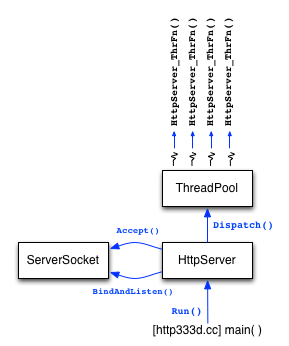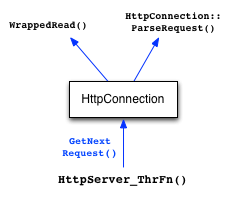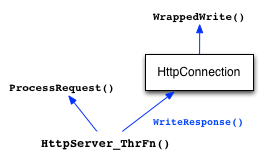CSE333 13au -- Homework #4A (1 of 3 alternatives)
out: Monday November 19, 2013
due: Wednesday, December 4, 2013, 11:59PM
Teams: Individual project only
[
summary |
part a |
part b |
part c
bonus |
how to submit |
grading ]
For homework #4, you will build on your homework #3 implementation
to implement a multithreaded Web server front-end to your query
processor. In Part A, you will read through some of our code to
learn about the infrastructure we have built for you.
In Part B, you will complete some of our classes and routines to
finish the implementation of a simple Web server. In Part C, you
will add several components to our Web server.
As before, pease read through this entire document before beginning
the assignment, and please start early!
In HW4, as with HWs 2 and 3, you don't need to worry about
propagating errors back to callers in all situations. You will use
Assert333()'s to spot some kinds of errors and cause your program to
crash out. However, no matter what a client does, your web server
must handle that; only internal issues (such as out of memory)
should cause your web server to crash out.
To help you schedule your time, here's a suggested schedule for
this assignment. We're not going to enforce the schedule; it's up
to you to manage your time.
- Read over the project
specifications and understand which code is responsible for what.
- Finish ServerSocket.cc. Make sure to
cover all functionality, not just what is in the unit tests.
- Implement FileReader.cc, which should be very
easy, and GetNextRequest in HttpConnection.cc.
- Complete ParseRequest in
HttpConnection.cc. This can be tricky as it involves both Boost
and regular expressions.
- Finish the code for
http333d.cc. Implement HttpServer_ThrFn in HttpServer.cc.
- Complete ProcessFileRequest and
ProcessQueryRequest in HttpServer.cc. At this point, you should be
able to search the "333gle" site and view the webpages available
under /static/,
e.g. http://localhost:5555/static/bikeapalooza_2011/index.html.
- Fix the security issues with the
website, if you have any. Implement your interesting feature.
- Make sure everything works as it is
supposed to.
Context.
 Our web server is a fairly straightforward multithreaded
application. Every time a client connects to the server,
the server dispatches a thread to handle all interactions
with that client. Threads do not interact with each other
at all, which greatly simplifies the design of the server.
Our web server is a fairly straightforward multithreaded
application. Every time a client connects to the server,
the server dispatches a thread to handle all interactions
with that client. Threads do not interact with each other
at all, which greatly simplifies the design of the server.
The figure to the right shows the high-level architecture of
the server. There is a main class called "HttpServer" that
uses a "ServerSocket" class to create a listening socket,
and then sits in a loop waiting to accept new connections from
clients. For each new connection that the HttpServer receives,
it dispatches a thread from a ThreadPool class to handle the
connection. The dispatched thread springs to life in a function
called "HttpServer_ThrFn" within the HttpServer.cc file.
 The HttpServer_ThrFn function handles reading requests from one
client. For each request that the client sends, the
HttpServer_ThrFn invokes GetNextRequest on an HttpConnection object
to read in the next request and parse it.
The HttpServer_ThrFn function handles reading requests from one
client. For each request that the client sends, the
HttpServer_ThrFn invokes GetNextRequest on an HttpConnection object
to read in the next request and parse it.
To read a request, the GetNextRequest method invokes WrappedRead()
some number of times until it spots the end of the request. To
parse a request, the method invokes the ParseRequest method (also
within HttpConnection). At this point, the HttpServer_ThrFun has a
fully parsed HttpRequest object (defined in HttpRequest.h).
 The next job of HttpServer_ThrFn is to process the request. To do
this, it invokes the ProcessRequest() function, which looks at the
request URI to determine if this is a request for a static file, or
if it is a request associated with the search functionality.
Depending on what it discovers, it either invokes ProcessFileRequest()
or ProcessSearchRequest().
The next job of HttpServer_ThrFn is to process the request. To do
this, it invokes the ProcessRequest() function, which looks at the
request URI to determine if this is a request for a static file, or
if it is a request associated with the search functionality.
Depending on what it discovers, it either invokes ProcessFileRequest()
or ProcessSearchRequest().
Once those functions return an HttpResponse, the HttpServer_ThrFn
invokes the WriteResponse method on the HttpConnection object to
write the response back to the client.
Our web server isn't too complicated, but there is a fair amount
of plumbing to get set up. In this part of the assignment, we
want you to read through a bunch of lower-level code that we've
provided for you. You need to understand how
this code works to finish our web server implementation, but
we won't have you modify this plumbing.
What to do.
- Fetch the additional source files for hw4 using
scp to attu: /cse/courses/cse333/13au/hw4.tar.gz.
Expand it in the directory containing the directories for the earlier homeworks.
- UPDATE: Use scp to attu to fetch
another tar file to that same directory and untar it to produce the projdocs/bikeapalooza_2011/
data file subtree.
- Run "make" to compile the HW4 binaries. One of them is
the usual unit test binary called "test_suite."
Run it, and you'll see the unit tests fail, crash
out, and you won't yet earn the automated grading points tallied
by the test suite. The second binary is the web server itself
(http333d). Try running it to see its command line arguments.
When you've completed enough code that you're ready to run it for real, you can use a command like:
./http333d 5555 ../projdocs ../hw3/unit_test_indices/*
(You might need to pick a different port than 5555 if another
student is using that port on the same machine as you.)
Try using our solution_binaries server, and running it using
a similar command line:
./solution_binaries/http333d 5555 ../projdocs ../hw3/unit_test_indices/*
Next, launch Firefox or Chrome on that machine, visit http://localhost:5555/, and try
issuing some searches. As well, visit http://localhost:5555/static/bikeapalooza_2011/Bikeapalooza.html
and click around. This is what your finished web server will be
capable of.
- Read through ThreadPool.h and ThreadPool.cc. You don't need
to implement anything in either, but several pieces of the project
rely on this code. The header file is well-documented, so it
ought to be clear how it's used. (There's also a unit test file
that you can peek at.)
- Read through HttpUtils.h and HttpUtils.cc. This class
defines a number of utility functions that the rest of HW4 uses.
Make sure that you understand what each of them does, and why.
- Finally, read through HttpRequest.h and HttpResponse.h.
These files define the HttpRequest and HttpResponse classes,
which represent a parsed HTTP request and response, respectively.
It's time to start coding in Part B.
Context.
You are now going to finish a basic implementation of the http333d
web server. We'll have you implement some of the event handling
routines at different layers of abstraction in the web server,
culiminating with generating HTTP and HTML to send to the client.
What to do.
- Take a look at ServerSocket.h. This file contains a helpful
class for creating a server-side listening socket, and accepting
a new connection from a client. We've provided
you with the class declaration in ServerSocket.h but no
implementation in ServerSocket.cc; your next job is to build it.
You'll need to make the code handle either IPv4 or IPv6 addresses.
Run the test_suite to see if you make it past the server socket
unit tests.
- Read through FileReader.h and FileReader.cc. Note that the
implementation of FileReader.cc is missing; go ahead and implement
it. See if you make it past the filereader unit test code.
- Read through HttpConnection.h and HttpConnection.cc. The two
major functions in HttpConnection.cc have their implementations
missing, but have generous comments for you to follow. Implement
the missing functions, and see if you make it past the
httpconnection unit test code.
- Now comes the hardest part of the assignment. Read through
HttpServer.cc, HttpServer.h, and http333d.cc. Note that some
parts of HttpServer.cc and http333d.cc are missing. Go ahead
and implement those missing functions. Once you have them
working, test your http333d binary to see if it works. Make
sure you exercise both the web search functionality as well
as the static file serving functionality. You'll probably need
to look at the source of pages that our solution binary serves
and emulate that HTML to get the same "look and feel" to your
server as ours.
At this point, your web server should run correctly, and everything
should compile with no warnings. Try running your web server and
connecting to it from a browser. Also try running the test_suite
under valgrind to make sure there are no memory issues. Finally,
launch the web server under valgrind to make sure there are no
issues or leaks; after the web server has launched, exercse it by
issuing a few queries, then kill the web server. (You'll leak a few
bytes by not shutting down the server cleanly, of course.)
Context.
Now that the basic web server works, you are going to add some
new functionality to it. There are two things you will do:
- Your web server (probably) has two security vulnerabilities.
We are going to point these out to you, and you will repair them.
- You will add a feature of your choice to the web server.
(We'll make a few suggestions.)
This part of the assignment is deliberately open-ended, with
much less structure than earlier assignments. This is the
culmination of the course; you're ready to handle this on
your own!
What to do.
- We bet that your implementation has two security flaws.
-
The first is called a "cross-site scripting" flaw. See
this for background if you're curious:
http://en.wikipedia.org/wiki/Cross-site_scripting
Try typing the following query into our example web
server, and into your web server, and compare the two. (Note:
do this with Firefox or Safari; it turns out that Chrome will
attempt to help out web servers by preventing this attack from
the client-side!)
hello <script>alert("Boo!");</script>
To fix this flaw, you need "escape" untrusted input from the
client before you relay it to output. We've provided you with
an escape function in HttpUtils.
- Try telnet'ing to your web server, and manually typing in a request for the following URL. (Browsers are smart enough to help defend against this attack, so you can't just type it into the URL bar, but nothing prevents attackers from directly connecting to your server with a program of their own!)
/static/../hw4/http333d.cc
This is called a directory traversal attack. Instead of
trusting the file pathname provided by a client, you need to
normalize the path and verify that it names a file within
your test_tree/ subdirectory; if the file names something
outside of that subdirectory, you should return an error
message instead of the file contents. We've provided you with
a function in HttpUtils to help you test to see if a path
is safe or not.
Fix these two security flaws, assuming they do in fact exist in
your server. As a point of reference, in solution_binaries/,
we've provided a version of our web server that has both of these
flaws in place (http333d_withflaws). Feel free to try it out, but
DO NOT leave this server running, as it will potentially
expose all of your files to anybody that connects to it.
- Figure out some interesting feature to
add to your web server, and implement it! As one idea, find the
implementation of a "chat bot", such as Eliza, and add it to your
web server. As another idea, implement logging functionality;
every time your server serves content, write out some record with
a timestamp to a log file; make the log file available through the
web server itself. As a third idea, change the results page to
show excerpts from matching documents, similar to how Google shows
excerpts from matching pages; specifically, make it so that each
result in the result list shows:
x words + <bold>hit word</bold> + y words
for one or more of the query words that hit.
Congrats, you're done with the HW4 project sequence!!
There is one bonus task for this assignment. As before, you can do
it, or not; if you don't, there will be no negative impact on your
grade. Your task is to perform a performance analysis of your web
server implementation, determining what throughput your server can
handle (measured both in requests per second and bytes per second),
what latency clients experience (measure in seconds per request),
and what the performance bottleneck is. You might want to look at
the "httperf" tool for Linux to generate synthetic load.
You should conduct this performance analysis for a few different
usage scenarios; e.g., you could vary the size of the web page you
request, and see its impact on the number of pages per second your
server can deliver. If you choose to do the bonus, please commit /
push a PDF file containing relevant performance graphs and analysis.
When you're ready to turn in your assignment, do the following:
- In the hw4 directory:
bash$ make clean
bash$ cd ..
bash$ tar czf hw4_<username>.tar.gz hw4
bash$ # make sure the tar file has no compiler output files in it, but
bash$ # does have all your source and other files you intend to submit
bash$ tar tzf hw4_<username>.tar.gz
- Turn in hw4_<username>.tar.gz using the course
dropbox linked on the main course webpage.
We will be basing your grade on several elements:
- The degree to which your code passes the unit tests.
If your code fails a test, we won't attempt to understand why:
we're planning on just including the number of points that the
test drivers print out.
- We have some additional unit tests that test a few additional
cases that aren't in the supplied test drivers. We'll be checking
to see if your code passes these.
- The quality of your code. We'll be judging this on several
qualitative aspects, including whether you've sufficiently
factored your code and whether there is any redundancy in your code
that could be eliminated.
- The readability of your code. For this assignment, we don't
have formal coding style guidelines that you must follow; instead,
attempt to mimic the style of code that we've provided you.
Aspects you should mimic are conventions you see for
capitalization and naming of variables, functions, and arguments,
the use of comments to document aspects of the code, and how code
is indented.
 Our web server is a fairly straightforward multithreaded
application. Every time a client connects to the server,
the server dispatches a thread to handle all interactions
with that client. Threads do not interact with each other
at all, which greatly simplifies the design of the server.
Our web server is a fairly straightforward multithreaded
application. Every time a client connects to the server,
the server dispatches a thread to handle all interactions
with that client. Threads do not interact with each other
at all, which greatly simplifies the design of the server.
 The HttpServer_ThrFn function handles reading requests from one
client. For each request that the client sends, the
HttpServer_ThrFn invokes GetNextRequest on an HttpConnection object
to read in the next request and parse it.
The HttpServer_ThrFn function handles reading requests from one
client. For each request that the client sends, the
HttpServer_ThrFn invokes GetNextRequest on an HttpConnection object
to read in the next request and parse it.
 The next job of HttpServer_ThrFn is to process the request. To do
this, it invokes the ProcessRequest() function, which looks at the
request URI to determine if this is a request for a static file, or
if it is a request associated with the search functionality.
Depending on what it discovers, it either invokes ProcessFileRequest()
or ProcessSearchRequest().
The next job of HttpServer_ThrFn is to process the request. To do
this, it invokes the ProcessRequest() function, which looks at the
request URI to determine if this is a request for a static file, or
if it is a request associated with the search functionality.
Depending on what it discovers, it either invokes ProcessFileRequest()
or ProcessSearchRequest().